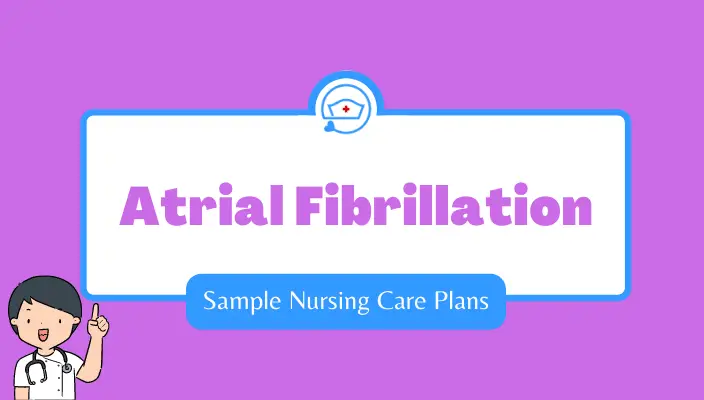Here we will formulate a sample nursing care plan for Dementia based on a hypothetical case scenario.
It will include three sample nursing care plans with NANDA nursing diagnoses, nursing assessment, expected outcome, and nursing interventions with rationales.
Dementia Case Scenario
An 86-year old female presents to the ED with complaints of confusion and memory loss. The patient’s daughter brought the patient to the hospital and reports that the patient has been acting progressively more strange for the last few months. The patient lives with the daughter, and she reports that the patient has been paranoid and agitated, intermittently convinced that she needs to leave the house for a hair appointment, even at odd hours and in the middle of the night. One time the patient even left the house with no shoes and without the daughter’s knowledge to go to the fictional hair appointment. In addition, the patient has been having difficulty with finding words, and the daughter also notes that she is now unable to complete her morning crossword puzzle.
Upon assessment, the patient can state her name and birthday but is disoriented regarding place, time and situation. She follows commands appropriately and her facial movements are symmetrical. The patient appears restless, frequently removing the blood pressure cuff and pulse oximeter. Her vital signs are stable, her temperature is 37.6 C, heart rate is 104 BPM, blood pressure is 103/76 mmHg, respirations are 22 breaths per minute, and her oxygen saturation is 98% on room air.
The patient’s blood work is within normal limits. A CT scan of the head is performed and no ischemic stroke or acute process is seen. However, an MRI of the brain reveals cortical atrophy with thinning gyri and widening sulci, indicative of dementia.
The patient is admitted to the hospital with a new diagnosis of Dementia
#1 Sample Dementia Nursing Care Plan – Disturbed thought process
Nursing Assessment
Subjective Data:
- The patient complains of confusion and memory loss
Objective Data:
- The patient is alert and oriented x1
- Cortical atrophy is seen on MRI
Nursing Diagnosis
Disturbed thought process related to degenerative brain changes as evidenced by confusion, memory loss, and disorientation
Goal/Desired Outcome
Short-term goal: For the duration of the shift the patient remains safe and calm, oriented to person and place.
Long-term goal: The patient can maintain enough physical and mental functioning to be able to safely live at home with her daughter
Dementia Nursing Interventions with Rationales – Disturbed thought process
| Nursing Interventions | Rationales |
| Administer cholinesterase inhibitors | This drug class includes medications such as donepezil (Aricept) and galantamine (Razadyne). They work by boosting a neurotransmitter called acetylcholine in the brain which improves communication between nerve cells |
| Administer NMDA receptor antagonists | This drug class includes medications such as memantine (Namenda) and works by blocking the action of a neurotransmitter called glutamate, slowing the progression of dementia |
| Anticipate PET scan | A PET scan can more precisely diagnose the different types of dementia |
| Anticipate a formal neurological evaluation | To assess the extent of degeneration and establish a baseline, a neurological exam will be performed to assess memory, problem-solving, senses, reflexes, balance, etc. |
| Anticipate cognitive and neuropsychological exams | Further testing will assess the patient’s reasoning, judgment, language skills, attention, etc. |
| Assess the patient for depression, anxiety, or sleep disturbances | These can occur in conjunction with dementia and medications may be needed to treat these issues individually |
#2 Sample Dementia Nursing Care Plan – Self-care deficit
Nursing Assessment
Subjective Data:
- The patient’s daughter reports confusion, agitation, and disorientation
Objective Data:
- The patient is disoriented regarding place, time, and situation
- Cortical atrophy is seen on MRI
Nursing Diagnosis
Self-care deficit related to disorientation secondary to degenerative brain disease as evidenced by confusion, agitation, and wandering
Goal/Desired Outcome
Short-term goal: By the end of the shift the patient will independently perform self-care activities such as brushing her teeth and washing her face
Long-term goal: The patient will be able to independently perform the majority of her ADLs
Dementia Nursing Interventions with Rationales – Self-care deficit
| Nursing Interventions | Rationales |
| Anticipate both inpatient and outpatient occupational therapy | This therapy is focused on helping the patient successfully perform activities of daily living and to prepare for future disability that may arise |
| Perform the functional assessment staging test (FAST) | This test can identify the severity of dementia, helping to determine the type of ADL support to anticipate |
| Simplify tasks for the patient | Patients with dementia have a difficult time performing complex tasks. Using simple words and clear instructions will help the patient successfully perform tasks |
| Encourage safe strength and range of motion exercises | Exercise improves strength and stamina, increasing independence and ease of ADL performance |
| Write out schedules and establish a routine | A step-by-step schedule and set routine can be very useful in helping the patient with dementia maintain independence |
#3 Sample Dementia Nursing Care Plan – Risk for injury
Nursing Assessment
Subjective Data:
- The patient reports confusion and memory problems
Objective Data:
- The patient is alert and oriented x1
- The patient has a history of wandering
Nursing Diagnosis
Risk for injury related to unsafe behaviors secondary to degenerative brain disease as evidenced by disorientation and history of wandering
Goal/Desired Outcome
Short-term goal: For the duration of the shift the patient will remain safe and will appropriately call for help if needed
Long-term goal: The patient will remain safe and free from injury while living with her daughter
Dementia Nursing Interventions with Rationales – Risk for injury
| Nursing Interventions | Rationales |
| Perform a fall risk evaluation and enact the appropriate precautions | Bed alarms and non-skid socks are strategies to avoid falls while the patient is in the hospital, but outpatient precautions may need to be taken as well, such as securing loose rugs or cleaning up clutter |
| Educate the family on safety strategies to utilize at home | Using childproof latches on cupboards that contain harmful chemicals, reducing the water temperature, or childproofing the stove are all strategies to avoid injury in the patient with dementia |
| Educate the family on strategies to help with wandering behavior | Installing an alarm system, camouflaging exterior doors, or having the patient wear a GPS device at all times are strategies to prevent or help with wandering behavior |
| Advise the family to use household labels | Labeling rooms (such as kitchen, bathroom, bedroom, etc.) or labeling hot and cold on faucets can be very helpful for patients with dementia |
Conclusion
To conclude, we created scenario-based three sample nursing care plans for Dementia. These nursing care plans include nursing assessment, NANDA nursing diagnosis, expected outcome, and nursing interventions with rationales.
Reference
Ackley, B., Ladwig, G., Makic, M., Martinez-Kratz, M., & Zanotti, M. (2020). Nursing Diagnoses Handbook: An Evidence-based Guide to Planning Care (12th ed.). Elsevier.
Herdman, T., Kamitsuru, S. & Lopes, C. (2021). NURSING DIAGNOSES: Definitions and Classifications 2021-2023 (12th ed.). Thieme.
Swearingen, P. (2016). ALL-IN-ONE CARE PLANNING RESOURCE (4th ed.). Elsevier/Mosby.




